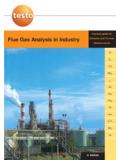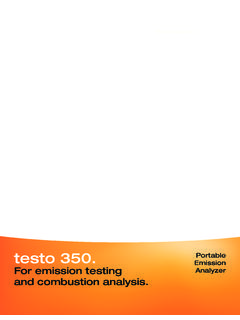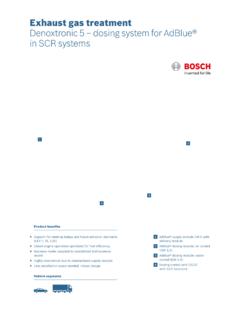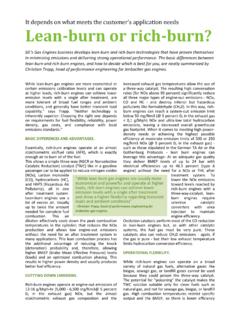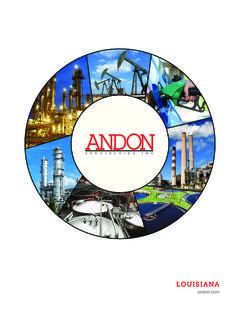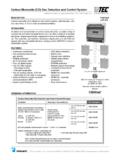Transcription of Practical guide for Flue Gas Analysis in Industry …
1 CO2 CONOx qAEtaCO2 Pm/sm3/hSO2t/a2. EditionPractical guide forEmission and ProcessMeasurementsFlue Gas Analysis in Industry31. Foreword52. The combustion Energy and Combustion Combustion air; excess air Stoichiometric and excess-air combustion; material Determination of the excess air Required combustion air Gas volume; dilution effect; reference Flue Calorific value; efficiency; flue gas Dew point; condensate223. Analysis of process gases in Combustion Process Firing Industrial Thermochemical surface Safety Emission Legal basis in Legal instructions in Emission Monitoring in the Flue gas cleaning444. Gas Analysis Terms of gas Analysis (selection) Concentrations; concentration Sample Gas Analysis Terms; application areas; analyzers; Measuring principles (used by Testo)615. Application of Testo gas Power Solid- fuel -fired Gas-fired Gas turbine Oil-fired Coal-fired power Combined heating and power Gas and steam power Waste Waste Waste Thermal gas Stone and clay Cement Ceramic/Porcelain Production of Glass Production of Metal Processing of Iron Production of raw Coke oven Aluminum Surface Chemical/petrochemical Process Residues Engine test beds1136.
2 Testo gas The Characteristic analyzer Industrial gas analyzers (overview) Gas analyzer accessories (overview) Technical description and data (Selection)126 Index134 Address list137 Content51. ForewordThis handbook is a valuable reference work for the application of portable flue gasanalyzer in Industry . Frequent questions arising from Practical use are answeredbased on the worldwide experience of many thousands of testo analyzer users. The handbook will save you the time consuming and sometimes difficult search for information in various sources. What is missing? What was not described as detailed as required?Your comments, amendments and suggestions are very much appreciated! They will be incorporated into a next edition. Just write to us; see the form for thaton page 138. We thank Dr. Ulrich Jecht for his commitment in writing this ManagementBurkart Knospe Lothar WalleserForeword62.
3 The combustion Energy and combustion Energy is defined as the ability of a material or system to perform labor. Energy exists indifferent modifications which can be classified into six categories as follows: Mechanical energy (flowing water, driving car) Thermal energy (boiling water, gas flame) Chemical energy (chemical reaction, burning process, explosion) Electrical energy (car battery, electricity) Electromagnetic energy (light radiation, microwave radiation) Nuclear energy (nuclear fission)The different energy modifications can be converted into each other, within an ideally closed system, with the sum remaining constant (conservation of energy). In practice, however, energy losses occur during the conversion process therebyreducing the efficiency. The natural energy carriers(coal, natural gas, crude oil, sun radiation, water power etc.) are described as primary energies,while the term secondary energiesstands for what is received from energy conversions (electricity, heat, etc.)
4 En-ergy carriers differ in energy content. For comparison reasons the energy con-tent is described as amount of energy which could be released from a certain quantity of an energy carrier in case of its total combustion. The energy scale unitis 1 Joule [J]. Some energy content values are given in table 1. Table 1: Energy content of fuelsEnergy carrier, 1 kg content [MJ]Brown coal9,0 Wood14,7 Hard coal29,3 Natural gas (1 m3)31,7 Crude oil42,6 fuel oil, light42,7 Gasoline43,5 For comparison: 1 kWh3,67 Combustion is the conversion of primary chemical energy contained in fuels such as coal, oil or wood into heat (secondary energy) through the process of oxidation. Combus-tion therefore is the technical term for the chemical reaction of oxygen with thecombustible components of fuels including the release of processes proceed with high temperatures (up to 1000 C and above).
5 The oxygen required for the combustion is supplied as part of the com-bustion air fed to the process. From that a considerable volume of exhaust gas (flue gas, off gas) is produced together with, depending on the kind of fuel , a cer-tain amount of residues (slag, ash). Oxidation Term for all chemical reactions of oxygen with other substances. Oxidation processes proceed with the release of energy and are of great importance inmany technical (combustion) and biological (breathing) areas. Greenhouse effectPrincipally the greenhouse effect is a natural process and one of the reasons forhuman life on earth. Without this effect, the global average temperature near the earth surface would be at -18 C instead of +15 C as it is; the earth wouldbe inhabitable for human beings! The cause for this natural effect is that the light radiation of the sun passes through the air and is absorbed by the earth then re-radiates this energy as heat waves that are absorbed by theair, specifically by carbon dioxide.
6 The air thus behaves like glass in a green-house, allowing the passage of light, but not of excessive firing of fossil fuels (emission of carbon dioxide) and release of certain substances from chemical Industry and agriculture (halogen hydrocar-bons, methane ) the natural effect will be amplified causing a slow increaseof the surface temperature with influence to the climatic conditions. More details to the objective of combustion are given in chapter Combustion plantsCombustion plantsare facilities that generate heat by burning solid, liquid orgaseous fuels. They are required for many tasks, heating (heating plants, building heating) generation of electrical energy generation of steam and hot water for use in process industries manufacturing certain materials (cement, glass, ceramics) thermal surface treatment of metallic parts incineration of waste materials and residuesSee detailed application examples in chapter 5!
7 Combustion occurs in a combustion chamber; other control units are required forfuel supply and fuel distribution, combustion air supply, heat transfer, exhaust gascleaning and for discharge of exhaust gases and combustion residues (ash, slag). Solid fuels are fired on a fixed or fluidized bed or in a flue dust/air mixture. Liquidfuels are fed to the burning chamber together with the combustion air as fuels are mixed with combustion air already in the burner. The exhaust gases of combustion plants contain the reaction products of fuel andcombustion air and residual substances such as particulate matter (dust), sulfuroxides, nitrogen oxides and carbon monoxide. When burning coal, HCl and HF may be present in the flue gas as well as hydrocarbons and heavy metals in caseof incineration of waste materials. In many countries, as part of a national environmental protection program, ex-haust gases must comply with strict governmental regulations regarding the limitvalues of pollutants such as dust, sulfur and nitrogen oxides and carbon monox-ide.
8 To meet these limit values combustion plants are equipped with flue gas cleaning systems such as gas scrubbers and dust filters. For further information on the regulations see chapter 3. Fuelsare available in different forms and composition: Solid fuels(hard coal, bituminous coal, peat, wood, straw) contain carbon (C),hydrogen (H2), oxygen (O2), and smaller quantities of sulfur (S), nitrogen (N2), and water (H2O). A major problem when handling such fuels is the formationof large quantities of ash, particulate matter and soot. Liquid fuelsderive mainly from crude oil and can be classified into light,medium and heavy fuel oils. Light fuel oil ( diesel fuel ) is widely used in smallcombustion plants. Gaseous fuelsare a mixture of combustible (CO, H2and hydrocarbons) andnon-combustible gases. Today very often natural gas is used, which containsmethane (CH4) as the main knowledge of fuel composition is important for an optimum and economicalcombustion process.
9 Increasing percentage of incombustible (inert) fuel compo-nents reduces the gross and net calorific value of the fuel and increases contami-nation of the furnace walls. Increasing water content raises the water dew point and consumes energy to evaporate water in the flue gas. The sulfur contained inthe fuel is burnt (oxidized) to SO2and SO3, which, at temperatures below the dewpoint, may lead to the formation of aggressive sulfureous and sulfuric acids. Seealso chapter composition of some solid fuels is shown in the following table:Table 2: Composition of solid fuelsFor details of gross and net calorific value see chapter FuelMass content in %Carbon in drymaterialSulfurAshWaterHard coal80-90153-10 Bituminous coal60-702530-60 Wood (air-dried) Combustion air; excess air valueThe oxygen required for a combustion process is supplied as part of the combus-tion air which consists of (see table 3) nitrogen (N2), oxygen (O2), a small amount of carbon dioxide and rare gases, and a variable content of water vapor.
10 In someprocesses pure oxygen or a air/oxygen mixture is used for the combustion air components, except oxygen, are all contained in the resultingraw flue gas. Table 3: Composition of clean and dry air Stoichiometric and excess-air combustion; material balance The minimal amount of oxygen required to burn all combustible components completely depends on the fuel composition. 1 kg of carbon requires 2,67 kgoxygen to be burnt completely, 1 kg of hydrogen requires 8 kg oxygen, 1 kg of sulfur however only 1 kg oxygen! Combustion occuring at these exact gas quantity ratios is called ideal combustion or stoichiometric combustion. The relevant equations areCarbon:C + O2iCO2 Hydrogen:2H2+ O2i2H2 OSulfur:S + O2iSO2 The ideal combustion procedure is shown schematically in figure 1. The amount of oxygen supplied to the combustion is just sufficient to burn all fuel combustiblescompletely.
